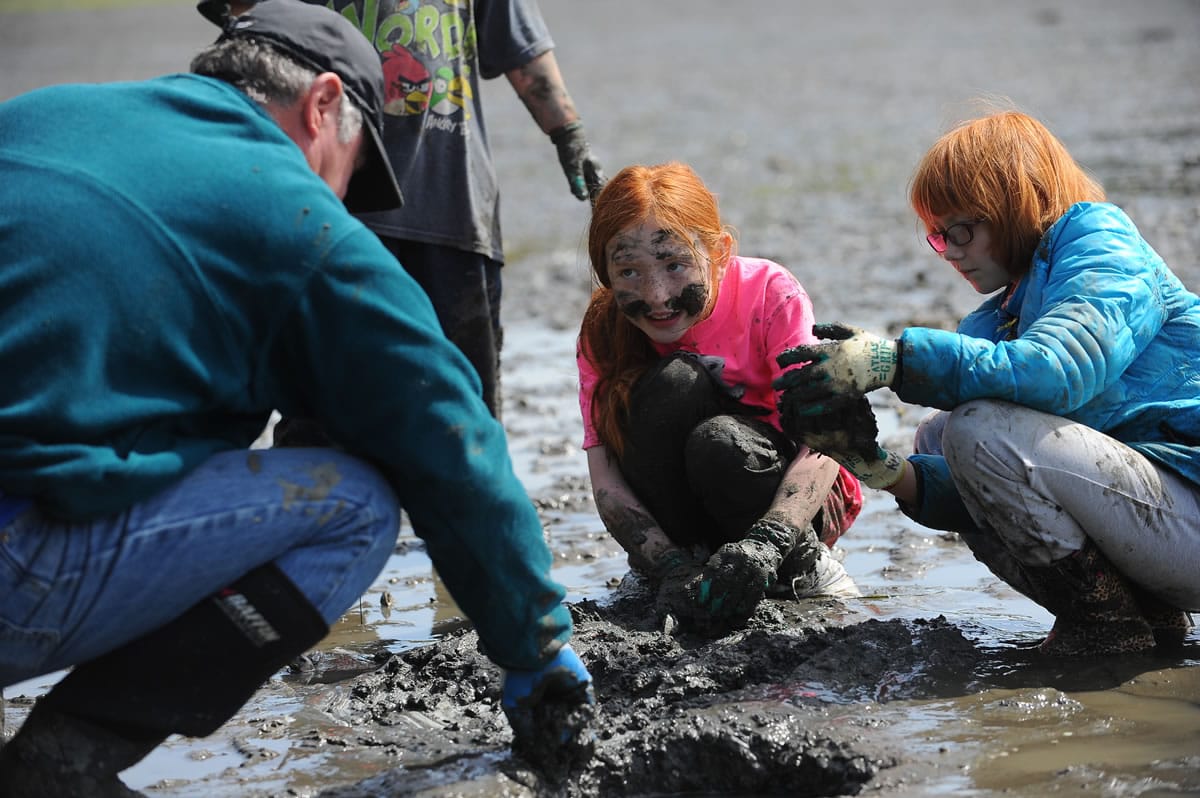BELLINGHAM — Mika Watabayashi pushed a shovel into the ground, lifted a small mound of goopy mud and plopped it onto a white plastic square.
The Bellingham third-grader sifted through what she dug up April 29 from north Chuckanut Bay, as did a few of her classmates in an adventure in messy hands-on science in their own watershed.
“Found one. Found one. I found more,” said Mika, a Wade King Elementary School student, as she searched for clams.
The school’s third-graders went to the sole-sucking mud flats to conduct a clam survey with the help of parents, volunteers from the Whatcom County Marine Resources Committee, and students from Bellingham Technical College’s Fisheries and Aquaculture Sciences program.
The field trip was part of the Garden of the Salish Sea Curriculum launched by the nonprofit Puget Sound Restoration Fund.
The project is in its third year of teaching students and the community what they can do to keep their watersheds clean and address global environmental issues. It uses shellfish to teach pollution prevention.
Wade King Elementary was participating in the program for the first time. The clam survey also was new this year.
The program’s goal is to be hands-on and to allow students to apply what they learn in the classroom out in the world.
“The material is so tactile and engaging,” said Julie Hirsch, a microbiologist with water-quality experience who developed the Garden of the Salish Sea’s environmental science curriculum.
As she spoke students in teacher Stacy McColl’s class split off to do a low-tide scavenger hunt while teacher Patty Keene’s class walked out on the mud flats, chattering excitedly and getting sucked into the muck — some of them — on their way to searching for clams.
They were sifting for horse, varnish, manila, native littleneck, macoma, cockle, butter, and eastern softshell clams.
Garden of the Salish Sea is aligned with Wade King’s focus as an international baccalaureate school, which includes a local and global perspective on being responsible for the community and the environment in addition to doing real-world science.
“How do scientists actually do a population count to determine what sort of impacts humans have had on their biome?” explained Ellen Alquist, who oversees the primary years program at Wade King, of the clam survey.
The information the students gathered about the number and types of live clams they found in the bay is being added to the data from previous clam surveys conducted in 2004 and 2008 by the Whatcom County Marine Resources Committee. Such surveys help track the health of the tidelands.
Before they headed out to the mud flats, the students learned in class how to identify the different clam species found in the bay as well as about the impact of fecal coliform and ocean acidification on shellfish.
Fecal coliform bacteria come from human and animal feces. The bacteria enter Whatcom County’s waterways in several ways — horse and cow manure, pet and wildlife waste, and failing septic systems. The bacteria could contaminate shellfish and sicken people who eat them.
North Chuckanut Bay, also known as Mud Bay, has had problems with fecal coliform.
Ocean acidification is caused primarily by oceans absorbing excess carbon dioxide released into the atmosphere, mostly through burning fossil fuels. It is altering ocean chemistry and making sea water more acidic — making it more difficult for oysters, clams and other sea creatures to build their shells.
“This isn’t just about educating kids. It’s about bringing the community in,” Hirsch said, adding that includes creating partnerships with local organizations that are working to sustain shellfish harvest and water quality in Whatcom County.
The work involves reaching out to adults through their children via the Salish Sea Challenge, which has steps people can take to keep the water clean and protect shellfish. Things they can do include turning off lights that aren’t being used, scooping their pet’s waste, and walking or riding their bikes instead of asking their parents to drive them.
Funding for Garden of the Salish Sea comes from a $70,000 grant from the Alcoa Foundation and an additional $20,000 from Whatcom Community Foundation over two years.
Hirsch has been able to expand the program and plans to reach a total of 800 students, teachers and family members this year and next in the Blaine, Bellingham and Ferndale school districts.
Fifth-grade students in Blaine, for example, learned about the Drayton Harbor watershed and take a field trip to the oyster farm in that body of water.
Fifth-grade students at Central Elementary — which has a number of students of Lummi and Nooksack descent — in Ferndale will learn about the Portage Bay watershed and the Lummi Nation’s oyster operations there.
Meanwhile, K-6 students at Lummi Island Beach School will take a shellfish garden tour on their island.



